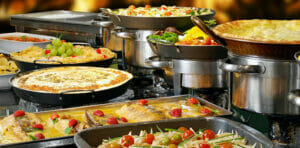Chefs bring a lot to the table: culinary expertise, operational know-how and a passion for giving their customers a great experience. They are a key audience for manufacturers to consider when developing products and launching them in the marketplace, as their perspective can bring about important insights throughout the process.
Our Corporate Executive Chef Joe Arvin brings that perspective to the Antunes internal teams, as well as rep groups, customers and prospects. Here, he shares what’s top of mind for today’s chefs and how current issues impact back-of-house operations.
Labor and the need for skilled employees
What keeps chefs up at night? Really what it boils down to is labor and skills. Even though we can get labor, we can’t get always get the skill level we need. We’ve traditionally had at least minimal skill levels ― someone’s learned how to cook, fry or work on the line. Nowadays, this level of skill is rarer, and instead, we’re seeing much younger, unskilled help. Raising minimum wage both helps us and hurts us; it may make the jobs more appealing but cuts down on already tight profit margins.
Chefs are working on ways to counteract some of the labor challenges ― offering a bonus or free meals, offering additional benefits like vacation time ― trying to incentivize people to work in the back of the house. We have to draw them in because they aren’t coming to us.
You no longer need a culinary degree to start in the kitchen. More and more we see the start of apprenticeships, which is one of the main ways we’re keeping employees. We’re training them, which is a trade-off for a lower wage. You can become a certified executive chef through an apprenticeship program. This is a trend we’re going to see going forward, like other trades. It’s our time to change the game.
Fortunately for chefs, Antunes offers equipment that cuts down on labor requirements through ease of use and reduced cleaning – adding easier equipment training and valuable time back into the balance.
Shrinking kitchens
We’ve dealt with shrinking kitchens for many years, and they’re getting smaller. Square footage is going up in price, so we have to find workarounds. To maintain the same level of output with less space, chefs need to redesign or reconfigure their kitchens. We have to think out of the box or we will not survive. At Antunes, we’re creating kiosks or stations that allow the customer to “plug-and-play” or drop in equipment in as small a footprint as possible.
Adoption of automation
Automation is coming — there’s no stopping it. Although it may initially look like jobs are being eliminated, it will actually shift to servicing the customer and creating a better customer experience in the restaurant and create jobs for those building and servicing the machines.
Looking for what’s next
The number one benefit of going to foodservice equipment trade shows like The NAFEM Show is seeing equipment innovation ― learning about new equipment before it hits the streets. Manufacturers want to show you their equipment and discuss what’s up and coming. Also, chefs want to learn about the ROI of the equipment and how soon they will recoup the costs. This savings could be due to better yield, greater efficiency, less waste or increased consistency ― which is a key consideration particularly for QSR chains.
See Chef Arvin in action at the 2019 NAFEM Show, where he will demonstrate how menus can come to life using Antunes equipment. Visit Booth #2429 and prepare to imagine something different with Antunes!


 Fantastic Flavors with the Antunes Flatbread Toaster
Fantastic Flavors with the Antunes Flatbread Toaster